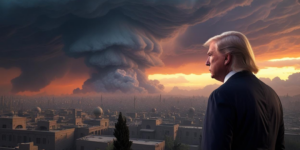Is This What Jesus Looked Like? AI Generates Depiction of Christ Using Mysterious Shroud of Turin
Artificial Intelligence (AI) has been used on the famous Shroud of Turin to reveal the image of the man on the cloth that some believe is Jesus Christ.
According to those who say it is a religious artifact, the shroud is the actual piece of cloth that was wrapped around Jesus’s body after his death on the cross. The resulting faint image left on the cloth was the result of an energy burst that happened at the time of Christ’s resurrection.
According to Relevant Magazine, the AI-produced image from the Shroud reveals a man with long, presumably dark brown hair and a beard. His eyes are open and looking straight at the viewer. The man’s neck is clearly defined, along with the top portion of his body which includes the shoulders.
The outlet noted, “While this is still simply a modern interpretation by a modern device, the results are stunning.”
In a social media post on Wednesday, The Case for Christ author Lee Strobel wrote: “According to Artificial Intelligence, this is what Jesus looked like if the Shroud of Turin is authentic.”
Strobel also included the image in his X post.
Critics pounced on what the resulting AI image appears to be.
Author Clinton S. Thomas wrote, “The AI, depending on the access it had, was likely to reference several popular images of Jesus in addition to the Shroud before making a picture. The Shroud gives no specific indication of eye color, skin color, hair color or clothing—this image includes all which indicates it is pulling from various images.”
Filmmaker Christian Newlands replied, “Interesting. There’s no confirmed historical record of Jesus having long hair though. The long hair descriptions stem from early depictions of Him from paintings of people in that time. In addition to His depiction, the description of Him in the book of Revelation is a description of Jesus resurrected, not living. No matter how accurate AI may like to be, it can’t be that accurate if the information that gets processed are only depictions.”
Others also pointed to the image’s hair. In the Bible, there are no verses describing Jesus’s hair. But there are verses in the Old Testament that describe how Jewish men were to take care of their hair, which was the law.
Based on these verses, Christianity.com noted in an article in 2019, that it is likely that Jesus had neatly trimmed black hair, long sideburns, and a beard.
Another user wrote, “Shroud history is fascinating. For instance, there is a reason why so many of the early icons of Christ look similar…. even though different artists painted them in different regions.”
Several users also noted the image looked “too feminine” or “too soft” due to the fact that Jesus of Nazareth was a carpenter by trade, a man described in scriptures as determined and strong.
Scientific Evidence Sheds Light on Ancient Mystery About the Shroud of Turin
Since it first popped up on history’s radar hundreds of years ago, the Shroud has captivated scientists, the public and people of God worldwide. The linen is viewed by some as the burial Shroud of Jesus Christ and others as an incredibly complex medieval forgery.
The story of the piece of cloth is an age-old tale that threads together a centuries-old debate about a religious artifact that has survived fires and a series of perils across a journey through history.
In an interview with CBN News last year, Brian Hyland, an exhibit curator at the Museum of the Bible said, “There have been questions about the veracity of this image ever since its first documented appearance in the late 14th century.”
In 1988, carbon testing dated the Shroud back to medieval times. But that test has repeatedly been called into question by various experts.
As CBN News reported in June 2022, a modern scientific procedure dated the fabric from the Shroud to roughly 2,000 years ago. That Italian study was the latest in a long series of scientific testing, including studies of pollen plucked from the Shroud with a scientific tape dispenser.
“The pollen samples that were gathered, they, a lot of them, are from plants that are native to not just the Middle East, but specifically the area around Judea, Palestine, and Syria and stay where it was in that time period,” Hyland told CBN News.
“There’s also pollen from the area around Constantinople. There’s a lot of pollen from Europe,” he said.
The pollen samples suggest a journey of thousands of miles from Jerusalem, through modern-day Turkey, France and now Italy, where the artifact has been kept since the 16th century.{eoa}
To read the full article, visit our content partners at CBN News.
Reprinted with permission from cbn.com. Copyright © 2023 The Christian Broadcasting Network Inc. All rights reserved.“
Join Charisma Magazine Online to follow everything the Holy Spirit is doing around the world!




























































